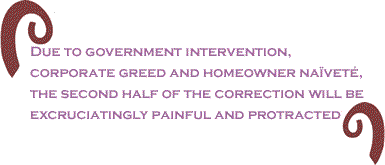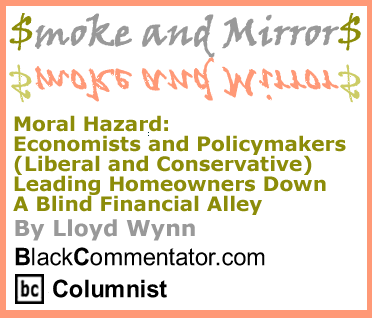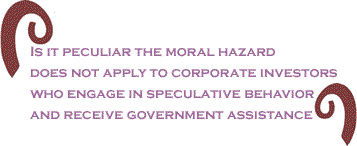
|
||||||||||||||||||||||
 |
||||||||||||||||||||||
 |
||||||||||||||||||||||
 |
||||||||||||||||||||||
 |
||||||||||||||||||||||
 |
||||||||||||||||||||||
 |
| The current issue is always free to everyone |
|
|
 |
Most experts will agree, we have entered an economic downturn unlike any other since prior to World War II. Housing starts and home sales have plummeted. Bankruptcy filings, unemployment and foreclosures have skyrocketed. When will we turn the corner and get back to normalcy? What you knew as normal will disappear with the final write down and Americans will be adjusting to a new economy. But before we get to the new economy, there is enormous pain we must still endure to purge ourselves of the bloat from the housing bubble, not to mention the remainder of the fluff from the dotcom and savings & loan bubbles. For the sake of brevity, I will assume the corrections to the economy have been made for the latter. However, the housing bubble, which encompasses so many other markets, is not deflated yet. Well-informed sources estimate the bubble to be $7 trillion. To date, homeowners have lost roughly $3 trillion in equity and to the extent these figures are close, we are about halfway through the correction cycle. Due to government intervention, corporate greed and homeowner naïveté, the second half of the correction will be excruciatingly painful and protracted. The economic forces are exerting downward pressure on artificial home values to correct the imbalance that is in the market today. Congress and the Administration are working on legislation, presumably to help homeowners save their home from foreclosure - huge mistake. Years from now, academicians will judge such behavior as unwise and premature. Here is the challenge to economists and policy makers: If the market is seeking equilibrium (unwinding) why put forward legislation to support inflated values? Essentially, the net results of legislative proposals are the same - a continuation of inflated home prices and/or a bailout for the banks. Evaluate Senator Chris Dodd’s (D, CT) and Rep. Barney Frank’s (D, MA) proposal or some hybrid thereof, commonly debated as foreclosure relief and ask yourself, “what does it accomplish”. At the core of the plan is a refinancing scheme available through the FHA with a reduction in principal. Let’s arbitrarily say a borrower owes $300,000.00 on the mortgage but the market value of the property has declined to $250,000.00. It is estimated that approximately ten million borrowers are similarly situated (typically referred to as upside down or underwater). The Dodd proposal will allow FHA to take the market value of the home ($250k) and refinance 85% of that amount which equals the new loan amount of $212,500.00 at a low interest rate. Instead of the borrower’s payment being calculated from $300k, now it will be calculated on a loan amount of $212,500.00 which will lower the payment substantially. The $50k difference between the original loan amount and the market value will probably become a “soft-second” mortgage, i.e. if the borrower sells the home at a profit, the $50k will be paid.
Understand, Sen. Dodd’s plan works fairly well in the immediate term but the long term consequences greatly outweigh the short-term benefits. Using the example above, the borrower’s property value is $250k today. Should the property value decline another 16%, the borrower will find herself in the same predicament again-underwater, that is, owing more than what the property is worth. One of the primary reasons borrowers default on their mortgages is because the principal balance exceeds the appraised value of the property. Analysts estimate roughly 26% of subprime and 23% of Alt-A loans originated in 2006 and 2007 will be underwater by midyear (Alt-A is a loan grade above subprime but below prime). 58% of subprime loans from this cohort are 60 days past due, while 33% of Alt-A loans are delinquent.
Given the supply and lack of demand or the inability
of the credit markets to satisfy the demand for housing, economists
and analysts forecast a declining market through 2010. If Congress
would bailout homeowners at this phase of the correction, the
inevitable (foreclosure) will be prolonged. BlackCommentator.com Columnist, Lloyd Wynn was a consultant in the secondary market. Lloyd is the author of Residential Real Estate Finance: From Application Through Settlement. Click here to contact Lloyd Wynn.
|
Your comments are always welcome. e-Mail
re-print notice
If you send us an e-Mail message we may publish all or part of it, unless you tell us it is not for publication. You may also request that we withhold your name. Thank you very much for your readership. |
|
| May
1, 2008 Issue 275 |
|
| Executive Editor: Bill Fletcher, Jr. |
| Publisher: Peter Gamble |
| Est. April 5, 2002 |
| Printer Friendly Version in resizeable plain text format format |
 |
 |
 |
| |
| |






























